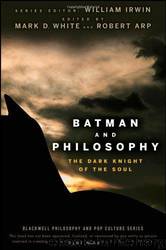Batman and philosophy: the dark knight of the soul by Mark D. White; Robert Arp

Author:Mark D. White; Robert Arp
Language: eng
Format: mobi, epub
Tags: Performing Arts, Philosophy (General), Social Science, Comics & Graphic Novels, Philosophy, Television, General, Popular Culture - General, Literary Criticism, History of Ideas & Popular Philosophy, Batman (Fictitious character), Popular Culture, Superheroes
ISBN: 9780470270301
Publisher: John Wiley & Sons
Published: 2008-05-30T07:00:00+00:00
Necessary Secret Identities
Modal logic is a formal language—much like mathematics—used to simplify the way we reason about possibility and necessity. In modal logic, certain logical rules (axioms) are near-universally accepted. Here are few examples: If something is necessarily true, then it is possibly true. If something is true, then it is possibly true. A more complicated example would be the following: if something is possibly true, then it is necessarily possibly true. An absurdly complicated example is this: if something is necessarily possibly necessarily possibly necessarily true, then it is necessarily true!
The ins and outs of modal logic aren’t of crucial importance here, but one thesis of modal logic is important: the Necessity of Identity (hereafter, “NI”). If NI is true, then identity claims—claims that include the identity symbol “=”—are necessarily true, if they’re true at all. Actually, NI is more specific. It applies only to certain identity claims. Specifically, NI says that identity claims that have names on either side of “=” are necessarily true if they’re true, and necessarily false if they’re false. For this reason, NI guarantees that “Harvey Dent = Two-Face” and the equivalent sentence “Harvey Dent is identical to Two-Face” are necessarily true. NI does not, however, guarantee that “Harvey Dent = the former district attorney of Gotham” is necessarily true. NI doesn’t apply to this sentence, since “the former district attorney of Gotham” is a description rather than a name.
Why should we believe NI? Because of IOI and the obvious claim that, necessarily, everything is identical to itself. Imagine that x and y are like variables in algebra; they stand for objects. Now, if everything is necessarily identical to itself, then, in every possible world, x = x. And if x = y in some possible world, then IOI entails that x and y must have all of the same properties. This means that if x = Batman and y = Bruce Wayne and x = y, IOI guarantees that Batman and Bruce Wayne share all the same properties. Well, one property x has is the property of being necessarily identical to x itself; therefore, IOI entails that y must also have the property of being necessarily identical to x. In Bat-terms, if Batman and Bruce Wayne are identical in some possible world, then, since Batman has the property of necessarily being identical to Batman, Bruce Wayne must also have the property of necessarily being identical to Batman. The conclusion of this compact but complicated argument is this: when things like Bruce Wayne and Batman are identical, they are necessarily identical.
If NI is true and “Batman” is a name, then we can make an argument showing that Batman couldn’t have been the Joker: Batman and the Joker aren’t identical on New Earth. Since Batman and the Joker aren’t identical on New Earth, “Batman = The Joker” isn’t necessarily true. But, given NI, if an identity claim is true, it must be necessarily true. Because “Batman = The Joker” isn’t necessarily true, we can conclude that “Batman = The Joker” can’t possibly be true.
Download
Batman and philosophy: the dark knight of the soul by Mark D. White; Robert Arp.epub
This site does not store any files on its server. We only index and link to content provided by other sites. Please contact the content providers to delete copyright contents if any and email us, we'll remove relevant links or contents immediately.
Cecilia; Or, Memoirs of an Heiress — Volume 1 by Fanny Burney(32067)
Cecilia; Or, Memoirs of an Heiress — Volume 3 by Fanny Burney(31463)
Cecilia; Or, Memoirs of an Heiress — Volume 2 by Fanny Burney(31413)
The Great Music City by Andrea Baker(30794)
We're Going to Need More Wine by Gabrielle Union(18640)
All the Missing Girls by Megan Miranda(14766)
Pimp by Iceberg Slim(13787)
Bombshells: Glamour Girls of a Lifetime by Sullivan Steve(13691)
Fifty Shades Freed by E L James(12923)
Talking to Strangers by Malcolm Gladwell(12887)
Norse Mythology by Gaiman Neil(12847)
For the Love of Europe by Rick Steves(11543)
Crazy Rich Asians by Kevin Kwan(8894)
Mindhunter: Inside the FBI's Elite Serial Crime Unit by John E. Douglas & Mark Olshaker(8708)
The Lost Art of Listening by Michael P. Nichols(7169)
Enlightenment Now: The Case for Reason, Science, Humanism, and Progress by Steven Pinker(6878)
The Four Agreements by Don Miguel Ruiz(6324)
Bad Blood by John Carreyrou(6283)
Weapons of Math Destruction by Cathy O'Neil(5842)
